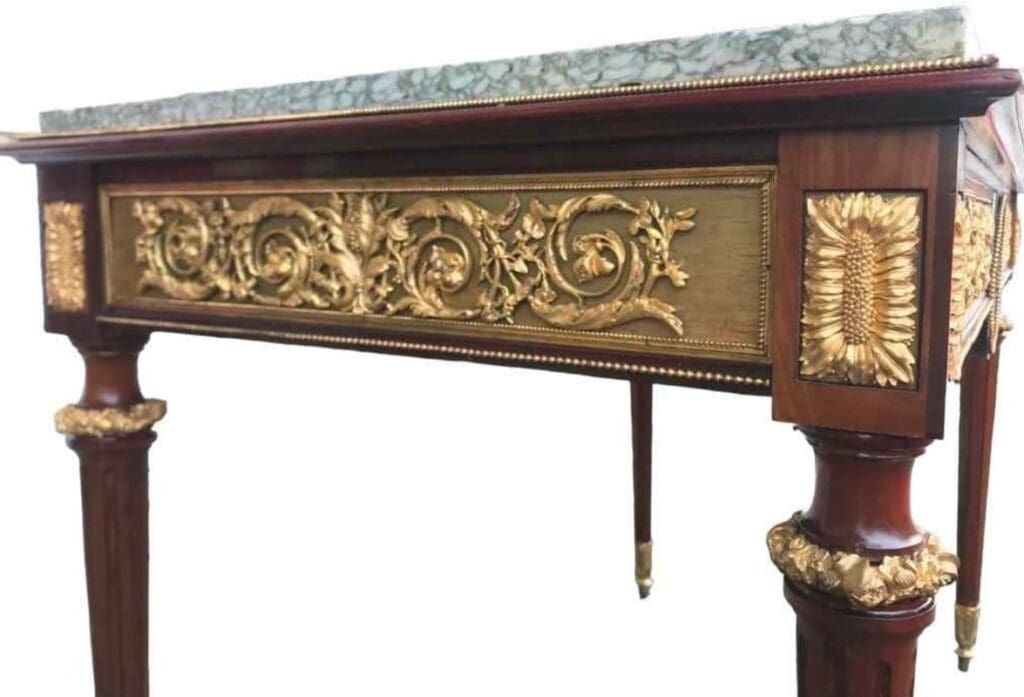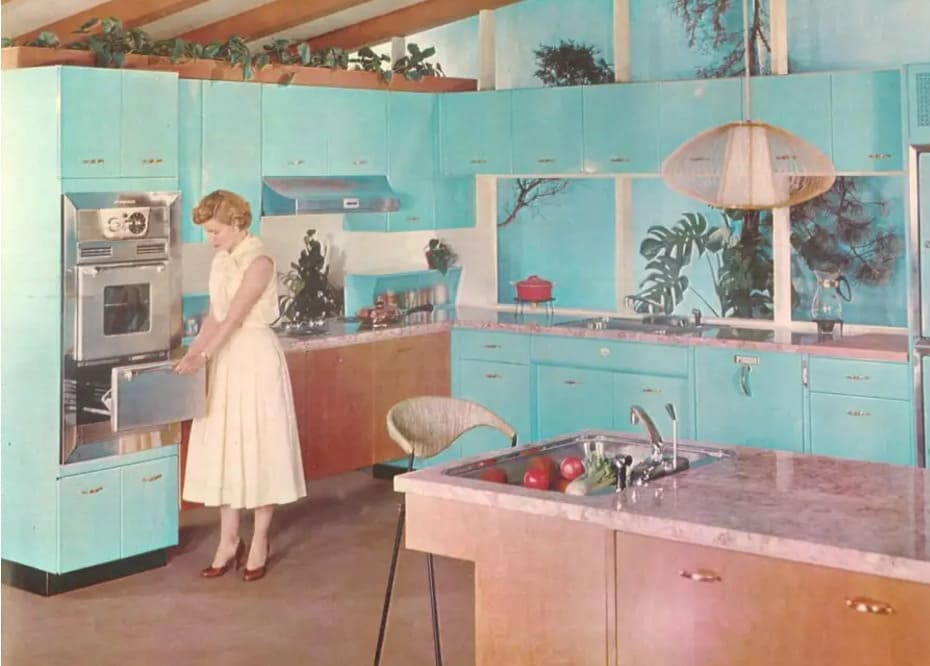A Brief History of Who Brought the Trend to Kitchen Surfaces
Stone countertops are not just a design element. They combine beauty, durability, and functionality, and most importantly, they remain timeless! Today, they adorn kitchens, bathrooms, BBQ areas, and laundry rooms, but their journey to becoming an everyday staple has been long and fascinating.
The history of stone countertops dates back to ancient times, through medieval Europe, and finally to the United States, where stone became a mainstream material. Who brought this trend to America? Why did marble, granite, and quartz become symbols of the perfect interior? In this article, we’ll explore all of this and more, including what countertops will look like in the future. So sit back and enjoy an exciting journey into the world of countertops!
Stone and wood — the foundations of furniture for our ancestors.
Just imagine, our ancestors once gathered around simple tables used for preparing food and sharing breakfasts, lunches, and dinners. Today, we can order any table made from any material, but one thing that remains the same is the countertop.
Neolithic period: Iconic items
The history of furniture dates back to the Neolithic period (around 8,000 to 4,000 years ago), when the first stone and wooden tables were used for ritualistic purposes. These primitive structures served more of a symbolic role than a practical one, but they marked the beginning of interior design development. Just imagine what the first table looked like. What strength it must have taken to set it up without special lifting equipment! How do you feel about such a massive countertop?

The ancestor of the countertop. Source: Julia Deming (Pinterest)
Ancient Egypt: Luxury and Status
In Ancient Egypt, furniture was a rarity, and only the noble classes could afford it. Stone was used to create altars, temples, and work surfaces. Historians believe that the first stone slabs might have adorned the kitchens of the nobility, where food was prepared for the pharaohs. This is likely the case. How did they manage without a lot of furniture? Today, it's hard to imagine a comfortable life without a soft bed with an orthopedic mattress...

This is what an Egyptian table might have looked like. Photo taken from open sources, authorship unknown.
Ancient Rome: Marble as Art
In Ancient Rome, furniture was more diverse. For the lower classes, the maximum luxury was a wooden table, but among the wealthy citizens, marble tables were common. These tables were not only practical but also served as decorative elements in interior design.
Excavations in Pompeii confirmed that marble surfaces were used in the homes of the nobility. These pieces were distinguished by their elegance, and their craftsmanship testified to the skill of Roman artisans.

An exquisite marble table from the National Archaeological Museum of Naples. (https://museoarcheologiconapoli.it/)
Middle Ages: Functionality and Simplicity
In Medieval Europe, furniture became even more utilitarian. Stone surfaces appeared in the kitchens of castles and monasteries, but they were rough and served solely for food preparation.

Rough countertops. Photo source: iStock
Stone countertops were more commonly found in castles and monasteries, where stone was used extensively. In the homes of commoners, countertops remained wooden.

Late Middle Ages. Photo credit unknown.
Renaissance: Elegance and Details
The Renaissance brought a new perspective to interiors. With advancements in marble processing techniques, the stone regained popularity. Work surfaces in the homes of the nobility were adorned with decorative carvings and intricate patterns.

Such an unusual leg design, intricate craftsmanship, and the spirit of the Renaissance are truly felt. Source: https://buffaloah.com/f/fstyles/ren/ren.html
The Renaissance stone countertops symbolized wealth and refined taste, complementing sophisticated interiors.
If you're currently thinking about updating your kitchen countertop, we recommend reading Which countertop is the best option for the kitchen: marble, granite, quartz?
Industrial Revolution: The Beginning of Mass Production
With the advent of the industrial era, furniture production became more accessible. Stone processing technologies improved, and countertops began to appear not only in the homes of the elite but also in middle-class households.
In the mid-19th century, quarries in Vermont began to actively develop, extracting marble that was used in construction and interior design. Meanwhile, in Massachusetts, granite became a symbol of strength and reliability.
Stone countertops in the USA
In the early 19th century, wealthy Americans began ordering marble products from Italy and France.

A 19th-century table made of mahogany and marble. Photo sourced from open sources. Author unknown.
Italy, with its famous Carrara marble, became the primary supplier. This is how stone countertops began to appear in the United States as a symbol of wealth and a sign of belonging to the elite. Italian immigrants also played a significant role in the development of the industry, bringing their stoneworking skills. They worked on the construction of large buildings and started using stone to create countertops with carvings and decorative elements.
Until around the 15th century, stone was extracted by looking for natural cracks in the blocks, driving wedges into them, and continuing to enlarge the split until the stone broke off. This was an expensive and not the safest method of extraction. However, it was the manual labor that preserved the stone's structure without changes.
Later, explosives were introduced to increase extraction speed, but unfortunately, this method damaged the stone, affecting its appearance. As a result, countertops made from lower-quality stone were much cheaper. Some workers returned to manual labor, while others continued to use explosives. It wasn't until the late 19th century, with the advent of spiral metal wires and later disc saws, that the extraction pace increased without compromising the quality of the stone.
After World War II, stone extraction and processing technologies became cheaper, and countertops began to appear in middle-class homes. This marked the beginning of the trend for countertops among homemakers, who had always valued having a beautiful kitchen. Countertops became an indispensable element in interior design, offering much more practicality and durability compared to wooden surfaces.

Such countertops gradually began to appear in middle-class American homes. Photo from 1958. Source: Recipes for Your New Kitchen
In the 1980s, diamond-coated wire saws were introduced for stone extraction. This technology allowed for the rapid extraction of 10-meter blocks from quarries.
After extraction, the stone was and still is transported to processing facilities. Today, these are factories where the stone is cut, polished, and honed using specialized equipment. The time from extraction to finished countertop has decreased from several months or even years to just a few weeks!


Modern marble extraction. Screenshot from Xprocess (Process-X)
The Peak of Countertop Popularity
Since the late 20th century, a new era of stone countertops began. In the 1980s, the mass production of engineered stone countertops started, and quartz agglomerates gained popularity. They were durable, easy to maintain, and offered a wide range of designs.
1980s–1990s: Granite became the standard for premium interiors. Americans appreciated its durability and unique patterns, while ordinary people favored ceramic tiles or engineered stone. This trend can be easily traced through films from that era. Let’s take a look at a few examples.

In the 1993 film Mrs. Doubtfire, we see a countertop made of two materials. There's visible tile work, and presumably, a material that resembles marble or granite in a dark color. (Screenshot from Mrs. Doubtfire (1993), directed by Chris Columbus.)

In the 1990 film Home Alone, it's clearly visible that the countertops are made of tiles. (Screenshot from Home Alone (1990), directed by Chris Columbus.)
In the 2000s, maintaining tile countertops became more difficult due to the numerous seams between the tiles, making them less convenient. Fashion also began to change. Countertops made from artificial stones became more popular. This material became the most in-demand, and is still widely used today, although its development began as early as the 1960s.

A still from the TV show 'Desperate Housewives'. The kitchen of Bree Van de Kamp from the 2000s. (Screenshot from Desperate Housewives (2004–2012), created by Marc Cherry)
What stone countertops are available today?
The variety of stone countertops available today is truly remarkable. Thanks to advancements in material processing and technology, you can find the perfect option for any interior and budget. Let’s explore the main types of stone countertops, their features, and their advantages.
- Granite
- Advantages: Durability, resistance to scratches and high temperatures, unique natural pattern.
- Disadvantages: Requires periodic sealing, heavy material.
- Marble
- Advantages: Elegant appearance, exquisite patterns, ideal for baking.
- Disadvantages: Prone to staining and scratching, requires careful maintenance.
- Quartz
- Advantages: Artificial material, resistant to stains and bacteria, wide variety of textures and colors, does not require sealing.
- Disadvantages: Not heat-resistant, may be more expensive than granite.
- Quartzite
- Advantages: Durable natural stone, heat-resistant, scratch-resistant, rich color palette with unique natural patterns.
- Disadvantages: Requires sealing to prevent stains, higher price compared to granite.
- Travertine
- Advantages: Soft natural shades, easy to work with.
- Disadvantages: Porosity makes it sensitive to stains, requires regular sealing.
- Slate
- Advantages: Matte texture, high heat resistance, easy maintenance.
- Disadvantages: Limited color options, fragility under heavy impact.
- Onyx
- Advantages: Exotic translucent material, dramatic backlighting enhances patterns.
- Disadvantages: Fragility, high cost, requires careful maintenance.
For practical solutions, granite, quartz, and quartzite are ideal. Those who appreciate luxury will enjoy marble and onyx. The choice depends on your preferences, functional needs, and budget!
The selection of countertop stones is vast, offering top picks for your kitchen Unveiling Top Picks for Your Kitchen under any budget. You can either focus solely on granite countertops or evaluate the pros and cons of marble ones.
What awaits us in the future?
I decided to let my imagination run wild and imagine what kitchen countertops might look like at the end of the 21st century. Technology will surely advance, and our lifestyle will change. Perhaps countertops, as we know them today, may no longer be needed, or maybe humanity will stop making toast with jam for breakfast, turning cooking into something much more, as we host guests for the evening.
Here are some possibilities for the countertops of the future:
Smart Surfaces
Countertops will be equipped with built-in AI that can suggest recipes based on the ingredients in the fridge, calculate the nutritional value, and take into account personal tastes, allergies, or even restrict certain foods during a diet. Touchscreen panels will be a must! These panels will display all kitchen appliances: the stove, fridge, microwave, and even allow you to control the lighting! Imagine this: you come home after work, with just one touch or even a voice command (which is much easier), you instruct the kettle to heat up, while you relax after a long day. And how about this? I also think countertops will be self-cleaning since, with these sensory surfaces, constant care and polishing will be necessary. Self-sufficient countertops, can you imagine that?
You know, it would be cool if countertops could print food by themselves. Like in the cartoon "Cloudy with a Chance of Meatballs."
I think countertops would be multifunctional and transform into different zones: for cooking, for working, or even disappear to create more space in the house. And those who still cook at home could read recipes from a holographic book or watch videos in mid-air.
Smart materials
Most likely, natural stone will be replaced by some kind of biotechnology. For example, if you accidentally drop something on the countertop, it will magically 'heal' the chip! Instead of marble and granite, biomaterials grown in labs, such as mushroom mycelium, recycled plastics, or even recycled carbon, will be used.
And who knows, maybe a 3D printer will print a unique countertop? Imagine: you want a countertop made of moonstone, and the printer creates it for you in just a few seconds! Cool!
If countertops are going to exist, do we all really need them? Perhaps, like in 2024, some people will cook at home or order delivery. But it all depends on the food. Instead of the usual pizza delivery, for example, there will be ready-made meals made from artificially grown products in laboratories. And even if humanity gets lazier, there will be courses or workshops like 'Improve your karma by making a cheesecake.' Haha, this is, of course, funny, but who knows what the future will really be like. Cooking will no longer be a routine task, but more of an entertainment.
The kitchen countertops of the late 21st century will combine art, science, and technology. They will not just be a place for cooking, but an intellectual platform connecting people, technology, and nature. Home cooking will become a luxury or a hobby, but it will never disappear completely. The kitchens of the future will inspire creativity, support health, and beautify our homes.
But I'm sure that in some homes, where cooking will be irrelevant, countertops will disappear, giving way to minimalist kitchens with compact food heating modules. However, in homes where traditions and lifestyle are valued, countertops will remain an important element of the interior, but they will change, becoming more technological and adaptive.

This is the countertop that DALLE generated based on my imagination
How to choose your perfect countertop?
The choice can sometimes be difficult, but you can read our article "How to choose a kitchen countertop: honestly about the strengths and weaknesses of natural and artificial stones" and figure out exactly what you want.
And if you want to take the easy route, it’s available! Check out our ranking of the best local countertop manufacturers, where you'll find contractors we've personally vetted and can confidently say won't let you down! Browse the companies' portfolios, evaluate their work, and get in touch with them to discuss your project. It’s simple and convenient!
Stone countertops have come a long way to become an integral part of your home. They are an element of interior design that adds practicality to daily routines. We effortlessly prepare breakfasts on them, but if we take a moment to consider that someone mined the stone, someone transported it, someone designed it, and someone installed it, we can appreciate the immense effort behind something that now brings beauty and joy to your space!
























